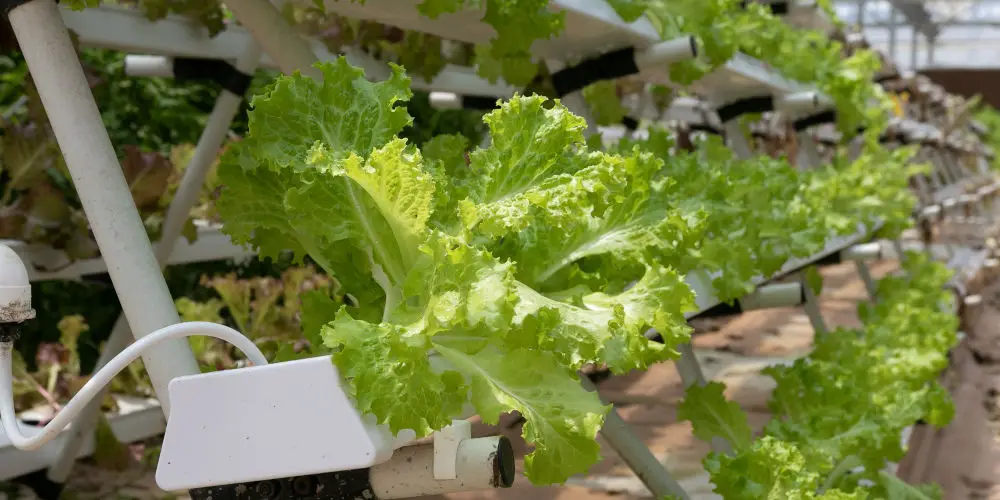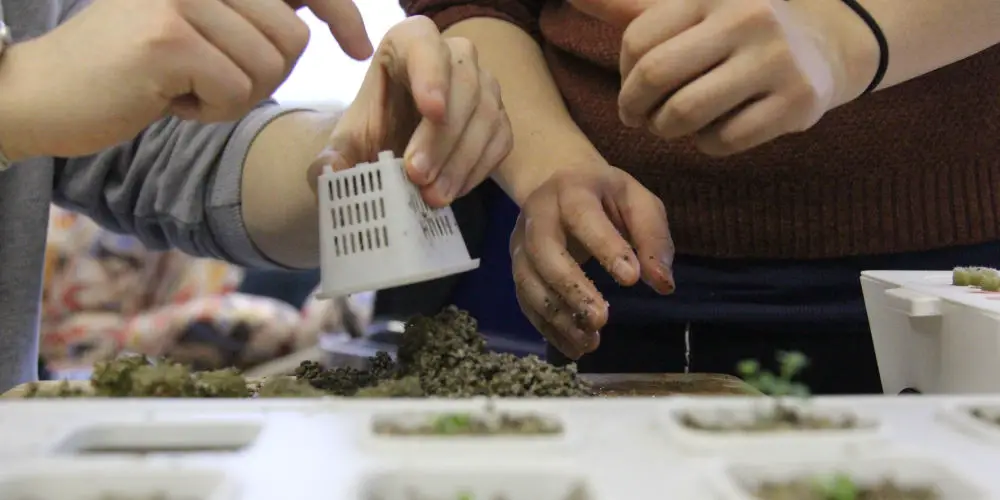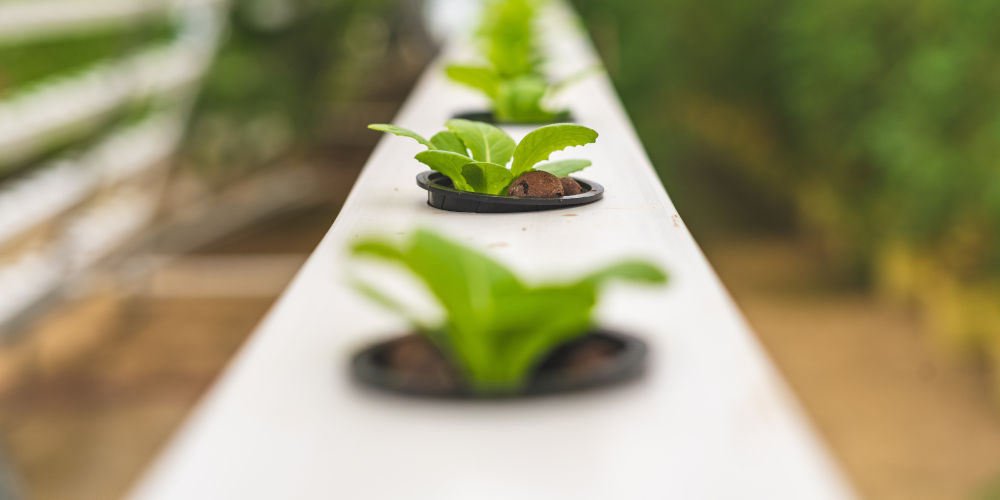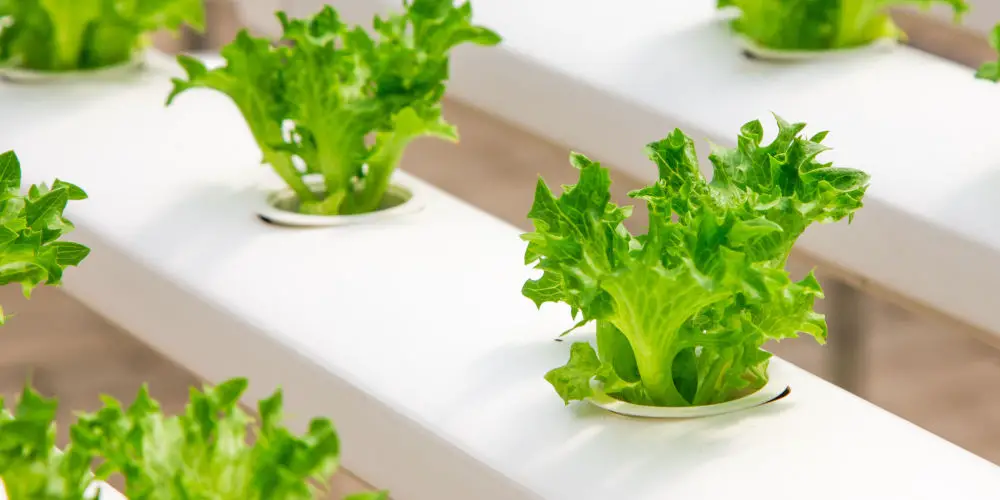Are hydroponics the garden of the future?

Growing plants and vegetables for most people involves sunlight, water and soil. It can take years to perfect growing cabbages or tulips. But this isn’t the only option we have, especially if we’re trying to create a smarter garden. Hydroponics is another option, albeit a less familiar one.
The arable farms of the future are likely to use hydroponic as this system allows the farmer to grow crops fast and cheaper while using less space. And while using hydroponic systems is in its infancy, the ideas are revolutionising the farming and food industry.
The great news is that you can apply the basics to a small DIY setup at home. Let’s explore what hydroponics is and how they help us build a smarter garden.
What is hydroponic gardening?
A hydroponics system enables us to grow plants using formulated, nutrient-rich water rather than in soil.
In hydroponics, the plant is suspended using a net pot which allows the plant to grow above the water. The roots pass through the netting and into the water solution.
Hydroponic systems have widespread appeal as they can be used both at home by gardening enthusiasts or on a large scale by farmers. If this sounds like modern technology, you’d be mistaken as we’ve been using the basic principles for thousands of years: Hydro (Water) + Ponics (Labour).
Advantages of hydroponics
- Higher harvest yield
- Uses less water than soil planting
- Takes up less space
- Almost any type of plant can be grown
- Food can be grown hydroponically in parts of the world not supported by traditional soil-based plants
- Environmentally friendly since most pesticides aren’t necessary
- Plants grow faster as they don’t continuously search for nutrients
- No seasonality as crops can be grown continuously
- Fewer pest problems.
Disadvantages of hydroponics
- Can be time-consuming to set up the system and manage
- Vulnerable to power outages
- Waterborne diseases
- Usually more expensive than traditional soil growing
- If a part fails, the system will cease to work properly
- Algae can build up and harm the system without proper care

What can be grown hydroponically?
You can grow almost any plant using hydroponics, including many different types of fruits, vegetables and flowers. You can even try growing plants and crops that don’t typically grow in the UK such as bananas, peace lilies, and carnations.
Six system types
The term hydroponics covers several different types of systems. There are six mains types, and each technique has its unique advantages and disadvantages.
Wicking
The easiest option to set up is a wicking hydroponics system as doesn’t need electricity. While electricity is not necessary, some use an air pump.
As the name suggests, this system uses a specific material that acts as the “wick” connecting the plant roots to the nutrient solution. The wick slowly absorbs the liquid delivering it to the plant roots.
The wick can be rope, felt, cotton, or even strips from a mop head. It needs to be something absorbent, allowing you the freedom to test different materials to see what works best for you.
The wicking system is ideal for growing herbs or other small plants.
Deep water culture (DWC)
Another basic system is deep water culture (DWC). In the DWC system, the plant roots are suspended and hang directly down into the nutrient solution.
As the roots sit directly in the nutrient solution at all times, there is no water being pumped around. Instead, an air pump provides oxygen to the water completing the system. These systems are ideal for larger plants especially as the roots have more room to develop than other systems.
The Kratky method is a popular DWC system that’s perfect for beginners as it eliminates all electrical components, allowing you to grow plants quickly and easily.
Drip system
A drip hydroponic system involves the nutrient solution being pumped through a tube above the plants. The nutrient solution drips down onto the plant and roots, allowing for close monitoring and accurate application.
However, with more drippers, problems can easily multiply. Plus, these systems can easily clog up, which can be a nightmare to solve.
There are two types of drip systems circulating and non-circulating. In a circulating system, the solution returns to the basin. Non-circulating means the nutrient-rich solution is only used once and isn’t recycled by the system.
Aeroponics
In an aeroponics system, the plant roots are suspended and sprayed with nutrient-rich water using an aerosol or misting spray. These systems use even less water than the traditional hydroponic system.
As the roots are suspended in air, they absorb even more oxygen. The system’s nozzles can spray the nutrient water continuously or intermittently. Future Gardens sells a highly affordable aeroponic starter kit.
Ebb and flow
An ebb and flow system (or flood and drain) involves filling a reservoir that your plants sit in. They are positioned above the nutrient reservoir water. The top tray with the plants gets flooded with the nutrient solution and then, at specific intervals, the water drains to the lower reservoir.
You can adjust the interval of the flooding by using a timer with your ebb and flow system. These systems are ideal for several plants that thrive under these conditions of excess nutrients followed by a period of dryness.
During the dry intervals, plant roots expand in search of more nutrients which causes faster growth overall.
Nutrient film technique (NFT)
Nutrient Film Technique is ideal if you want to increase the oxygen levels and decrease the amount of water used. The key difference with NFT systems is that they rely on the plants to be suspended in a row at a slight tilt. This tilt allows for gravity to move the water through the tips of the roots.
As the roots are almost entirely exposed to the air, NFT allows the plants plenty of oxygen. Also, only the tips of the roots touch the nutrient solution.
Hybrid
Hybrid systems can be created using a combination of any of these six methods. As the basic ideas, there are also plenty of other interesting subsets including aquaponics and fogponics.

What components do we need?
Depending on the type of system you use, you’ll need different equipment. All systems feature the same basic components with some optional extras.
Nutrient-rich solution
Without the correct hydroponic nutrient solution, you can’t grow anything. If we were growing plants in soil, this would be water. However, as we’re not using soil, we need to use a liquid solution, which our plants can derive their nutrients from.
The nutrient solution is held in the reservoir and gets pumped up or sprayed onto the roots. Regardless of which of the six systems you use, the nutrient solution is critical.
You can use a premixed nutrient solution or mix a variety of chemicals and water to create the solution as and when needed. As an introductory guide, this is as deep as we’ll get, as this can get technical and varies depending on what you’ll be growing.
You’ll want to change your nutrient solution every two to three weeks. When you change it, check the pH level and aim for a pH level of 6.5. You can easily test your solution using any pH meter.
Reservoir
The reservoir holds the nutrient-rich water solution and is typically a lower tank or tub. In most systems, we need to move the solution from the reservoir, up to the grow tray. We can use pumps, wicks, or nothing if the roots will sit in the reservoir solution.
Typically, reservoirs are plastic tubs that are solid, water-tight and affordable. Ideally, thicker plastic tubs are best as they stop light from getting in and won’t leak. That said, it’s always worth covering your tub in heavy material to stop light from getting through.
Growing tray
The growing tray (or growing chamber) is where the plants sit as they develop from seed to plant. The size of your growing tray can vary based on how many plants you have and how big they will get. So, it’s best to start with a smaller tray and grow from there (pardon the pun)!
Growing medium
As hydroponics allows you to grow plants without soil, we need a growing medium, which acts as a soil substitute. The growing medium supports your plant and roots by absorbing the solution and keeping the plants moisturised.
Hydroponic media are measured by how absorbent they are, and how porous they are to allow oxygen in. There are plenty of options, including:
- Rockwool
- Rocks
- Floral foam
- Sand
- Expanded clay pebbles
- Polyfoam insulation.
Submersible pump
Most systems use a pump to transport the nutrient solution from the reservoir to the plant roots. You can find these types of pumps online or in garden stores in the pond or pump section. A range of different sizes is available allowing you to buy one that best suits your system.
As the pump lives in the water solution, you’ll want to clean and maintain it regularly for proper functionality.

Optional extras
Now we’ve discussed the major components, it’s worth turning our attention to the optional extras. You don’t need these but they will help you grow plants faster and better.
Air Pump
We encourage using an air pump as more oxygen means more growth. The air pump provides oxygen to the nutrient-rich solution and, in some systems, to the plant roots. Typically, oxygen is pumped through the bottom of the reservoir, adding bubbles to your solution.
You can find suitable air pumps at most aquarium supplies shops. Having a pump is necessary if your roots are always in the solution as they help ensure your roots aren’t suffocating.
Grow lights
If you can’t use natural sunlight, you’ll need to utilize an artificial light source. Several different lighting types are available with the best being an LED grow light.
LED grow lights use less electricity and last longer than standard fluorescent bulbs. They do cost more upfront, but the overall savings pay for themselves. Another benefit of LED lights, is they have an adjustable colour spectrum, allowing you to tweak the colour to the plant.

What does a hydroponic system need?
A complete system consists of a nutrient-rich water solution, a light source (sun or artificial), seeds, and a growing medium.
Does hydroponics yield more than soil?
Yes, a well-calibrated system can grow plants up to 30% faster than the traditional soil-based approach. However, you need proper nutrients in your water solution and great lighting.
Should You Try Hydroponics at Home?
Hydroponics is a great way to grow healthy plants at home without using soil. Growing plants using hydroponics will result in higher yields and fast, amongst many other benefits.




